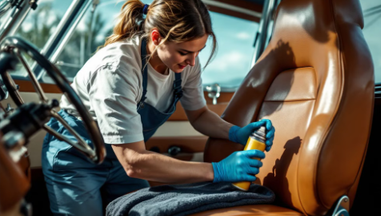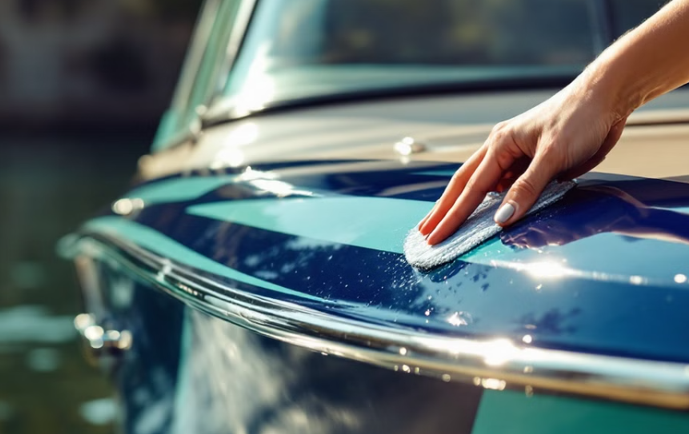FAQs for Boat Detailing
The top 10 questions about boat detailing, expanded with comprehensive answers to address the needs of boat owners.
1. How Often Should I Detail My Boat?
The frequency of detailing depends on how often you use your boat and the environment in which it operates. For boats regularly exposed to saltwater, detailing every 3-4 months is ideal to prevent corrosion and salt buildup. Freshwater boats may only require detailing twice a year. However, if your boat is used heavily or frequently, consider more frequent cleaning to maintain its condition. Regular rinsing and interim cleanups can help prolong the effects of a full detail.
2. What Is the Difference Between Cleaning and Detailing a Boat?
Cleaning is the process of removing surface dirt, grime, and stains, typically through washing and scrubbing. It’s a routine maintenance task that ensures your boat remains presentable and functional. Professional Boat Detailing, on the other hand, is a more comprehensive and meticulous process that involves deep cleaning, polishing, and protecting all areas of the boat, including the gelcoat, metal fixtures, upholstery, and interior. Detailing often involves the use of specialized products like wax, sealants, and UV protectants to preserve the boat’s materials and extend its lifespan.
3. Can I Use Household Cleaners for Boat Detailing?
Household cleaners are not recommended for boat detailing as they are not designed for marine-grade materials. Many household cleaners contain harsh chemicals that can strip protective waxes, damage gelcoats, or degrade upholstery. Instead, use marine-specific cleaning products that are formulated to be safe on boat surfaces while providing effective cleaning power. For instance, marine-grade soaps, vinyl cleaners, and metal polishes are tailored to withstand the harsh conditions of boating environments.

4. How Do I Remove Tough Stains, Like Rust or Algae?
Tough stains such as rust or algae require targeted cleaning products. For rust, use a marine-grade rust remover or metal polish that breaks down oxidation without damaging the surface. Algae can be tackled with specialized cleaners that dissolve organic growth while protecting the boat’s finish. Always test any cleaner on a small area first to ensure it won’t harm the surface. After removing the stain, rinse thoroughly and reapply wax or polish to restore the protective coating.
5. Is It Necessary to Wax My Boat After Every Cleaning?
Waxing your boat after every cleaning is not necessary, but it is crucial to include waxing as part of a detailing routine. Wax acts as a protective layer against UV rays, saltwater, and environmental pollutants, preserving the boat’s shine and gelcoat. Most boats benefit from a waxing session every 3-6 months. However, spot waxing high-wear areas, such as the bow or waterline, can prolong the protective effects between full wax applications.
6. How Can I Prevent Mold and Mildew in My Boat’s Interior?
Mold and mildew thrive in damp and poorly ventilated conditions, making boats particularly susceptible. To prevent their growth, ensure proper ventilation by keeping hatches and windows slightly open when the boat is not in use. Use moisture-absorbing packets or a dehumidifier in enclosed spaces to control humidity levels. Regularly clean upholstery and hard surfaces with mold-preventive sprays or mild disinfectants, and dry the interior thoroughly after each use.

7. What Are the Benefits of Using a Ceramic Coating on My Boat?
Ceramic coating provides a durable, hydrophobic barrier that protects your boat from UV rays, oxidation, and water spots. Unlike wax, which wears off over time, ceramic coatings last for years with minimal maintenance. The coating repels dirt, algae, and grime, making your boat easier to clean and reducing the frequency of detailing. While ceramic coatings require professional application, their long-lasting benefits can outweigh the upfront cost for many boat owners.
8. How Should I Care for My Boat’s Upholstery and Vinyl?
Upholstery and vinyl require gentle yet thorough care to maintain their appearance and functionality. Clean them with mild, non-abrasive cleaners formulated for marine fabrics, ensuring that they are free of harsh chemicals. Avoid scrubbing with hard-bristle brushes, as these can damage the material. Applying a UV protectant designed for marine vinyl helps prevent fading, cracking, and drying out from sun exposure. Make it a habit to clean and condition your upholstery after every outing. Interior Boat Detailing is an important part of boat maintenance, and neglecting it can result in cracking and staining.
9. Is Pressure Washing Safe for My Boat?
Pressure washing is safe for most parts of a boat when done correctly. Use a moderate pressure setting to remove dirt and grime without damaging delicate surfaces. Avoid using high pressure on areas like the gelcoat, vinyl, or seals, as it can cause scratches or leaks. For stubborn dirt, combine pressure washing with marine soap to achieve a thorough clean. Always hold the nozzle at a safe distance (at least 12 inches) from the surface to prevent damage.
10. What Should I Do If My Boat’s Gelcoat Becomes Oxidized?
Oxidation causes the gelcoat to appear dull and chalky, detracting from your boat’s appearance. To restore it, start with a marine-grade rubbing compound to remove the oxidized layer. Apply the compound with an orbital polisher for an even finish, followed by a polish to restore the gelcoat’s shine. Finally, apply a coat of wax to seal and protect the restored surface. For severe oxidation, professional detailing may be necessary to achieve the best results.
By addressing these frequently asked questions, boat owners can gain a deeper understanding of the importance of detailing and how to approach it effectively. Proper care and maintenance ensure that your boat remains not only visually appealing but also protected against the rigors of marine environments.
